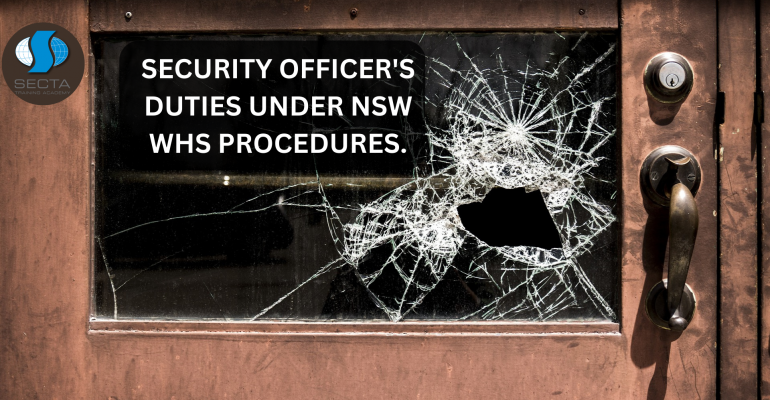SECURITY OFFICER’S DUTIES UNDER NSW WHS PROCEDURES.
3 May 2023 2023-05-03 8:07SECURITY OFFICER’S DUTIES UNDER NSW WHS PROCEDURES.
SECURITY OFFICER’S DUTIES UNDER NSW WHS PROCEDURES.
To apply work health and safety and emergency response and evacuation procedures to maintain security under the NSW Health and Safety Act 2011, you can follow these additional steps:
Conduct a security risk assessment: Start by identifying potential security risks in the workplace, such as theft, vandalism, or violent incidents. Conduct a security risk assessment to determine the likelihood and potential consequences of each risk.
Implement security measures: Implement appropriate security measures to prevent or minimise the risk of security incidents. This may include installing security cameras, access control systems, and security lighting, or implementing security protocols such as visitor sign-in procedures.
Train workers: Ensure that workers are trained in security measures, emergency response and evacuation procedures, and their roles and responsibilities in maintaining a secure workplace.
Maintain records: Keep records of security risk assessments, security measures, training, and security incidents that occur in the workplace.
Regularly review and update: Regularly review and update security risk assessments and security measures to ensure that they remain effective and relevant.
Respond to security incidents: In the event of a security incident, follow the emergency response and evacuation procedures in place and ensure that all workers are accounted for. Notify the appropriate authorities, such as the police or emergency services, if necessary.By following these additional steps, you can apply work health and safety and emergency response and evacuation procedures to maintain security under the NSW Health and Safety Act 2011 and help to create a safe and secure workplace for all.
SECURITY COMPANY’S RESPONSIBILITIES
under the NSW Health and Safety Act 2011, security employers are required to consult with their workers about health and safety measures. The Act requires that employers consult with their workers on matters that directly affect or are likely to affect their health and safety at work. This includes consulting with workers on the development and implementation of health and safety policies, risk assessments, and control measures.
Specifically, section 47 of the Act states that an employer must consult with their workers when:
Identifying hazards and assessing risks in the workplace;
Making decisions about how to control risks and implement measures to ensure health and safety;
Making decisions about the adequacy of facilities for the welfare of workers;
Developing procedures for the resolution of work health and safety issues;
Developing information and training programs for workers regarding work health and safety.The Act also requires that workers are provided with a reasonable opportunity to express their views and that their views are taken into account by the employer in decision-making processes.
In the case of security employers, this may involve consulting with workers on matters such as the provision of appropriate training and equipment, risk assessments for security operations, and the development and implementation of emergency response and evacuation procedures.
DUTIES AND RESPONSIBILITIES OF SECURITY OFFICERS
Under the NSW Health and Safety Act 2011, workers have a duty to take reasonable care for their own health and safety, as well as the health and safety of others who may be affected by their work. Workers are required to comply with any reasonable instruction given by their employer to ensure health and safety in the workplace, and to cooperate with their employer in any measures taken to comply with the Act.
More specifically, the duties and responsibilities of workers under the Act include:
Taking reasonable care: Workers must take reasonable care to ensure that their actions do not cause harm to themselves or others in the workplace.
Following health and safety policies and procedures: Workers must comply with any health and safety policies and procedures that are in place in the workplace.
Using personal protective equipment (PPE): Workers must use any PPE that is provided to them by their employer, and use it in accordance with the instructions provided.
Reporting hazards and incidents: Workers must report any hazards, incidents or injuries that occur in the workplace to their employer or supervisor as soon as possible.
Cooperating with their employer: Workers must cooperate with their employer in any measures taken to comply with the Act, such as participating in health and safety training or assisting in the investigation of incidents.
Not interfering with health and safety measures: Workers must not wilfully or recklessly interfere with any health and safety measures or equipment provided in the workplace.It’s important to note that the duties and responsibilities of workers under the Act are in addition to the duties and responsibilities of their employer. By working together, employers and workers can create a safe and healthy workplace for everyone.
www.secta.com.au



